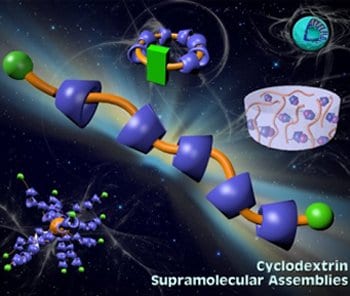 Expanding interest in supramolecular polymer chemistry has resulted in a wide range of advanced functional materials with sophisticated molecular architectures. Thereby, the self-assembly of macromolecular systems into highly ordered, nanostructured functional assemblies is of particular interest. Driven by non-covalent interactions, such as inclusion complexation, sophisticated molecular architectures with high specificity and functionality can be achieved.
Expanding interest in supramolecular polymer chemistry has resulted in a wide range of advanced functional materials with sophisticated molecular architectures. Thereby, the self-assembly of macromolecular systems into highly ordered, nanostructured functional assemblies is of particular interest. Driven by non-covalent interactions, such as inclusion complexation, sophisticated molecular architectures with high specificity and functionality can be achieved.
Cyclodextrins (CDs) are a class of cyclic oligosaccharides consisting of six to eight glucose units, which through their hydrophobic interior cavity can undergo reversible, yet selective, non-covalent interactions with various appropriately sized guest molecules and polymers. Although first used in pharmaceutical formulations as drug-eluting and stabilizing compounds, CDs have as of late found new applications as advanced functional materials. This has renewed the interest in CDs across a broad range of disciplines. Using CD-based inclusion chemistry as a platform, a wide range of polymeric networks have been fabricated with application in the life sciences, biotechnology and materials science, including materials for molecular recognition, fluorescence sensing, drug delivery, chiral separation, actuators, scratch resistant and self-healing materials, as well as elastomeric, and shape memory materials.
The group around Greg Qiao (University of Melbourne, Australia) now highlights the versatility of CD-based inclusion chemistry, and how specificity and control can be imparted when designing higher-order structures, such as those found in biological systems. A particularly interesting group of polymeric structures that is achievable via CD-based inclusion chemistry is that of supramolecular hydrogels, which are discussed in detail. These hydrogels can be engineered to display dynamic sliding-ring or reversible cross-linking, as well as specific binding sites. Although the breadth of study in this field has mainly focused on preparing CD-based hydrogels (and supramolecular structures) for sustained drug release and in-situ gelling systems, the implementation of these constructs towards tackling specific real world issues is still in its infancy. In addition to providing current advances and future directions within this emerging field, consideration is also given to the potential complications that will become apparent as this field matures, and how they could be overcome.

















